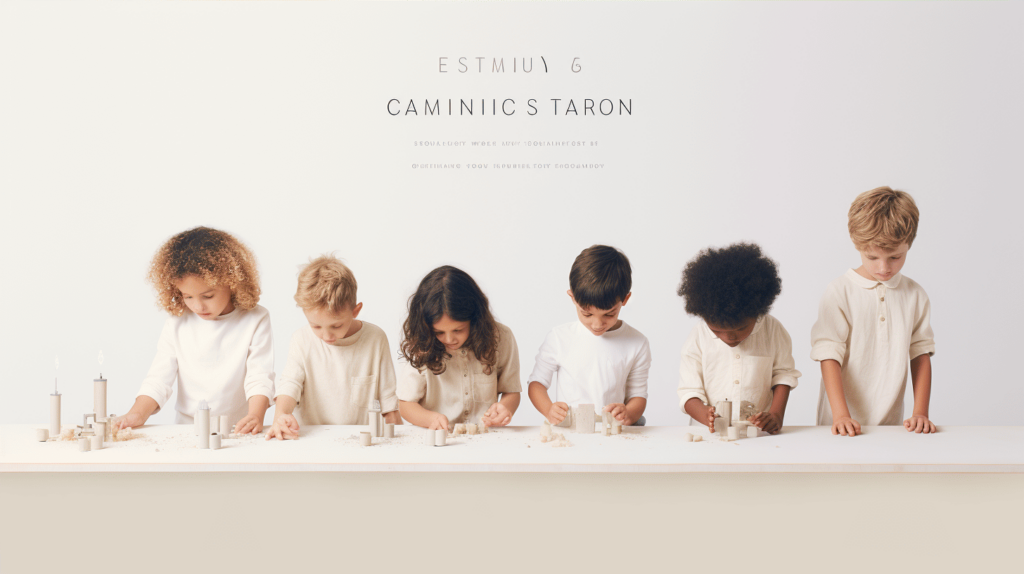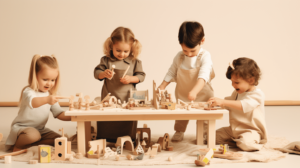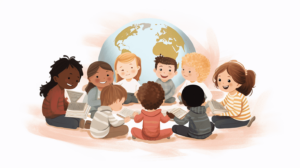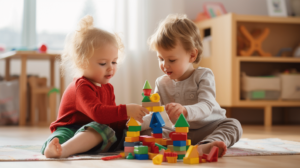
Sibling Relationships – Tips for Encouraging Bonding
Discover effective tips for nurturing sibling relationships and fostering a strong bond between siblings. Create lasting connections and promote harmony.
Hello there, science enthusiasts! 🚀 We all remember science as a fascinating subject in school, where we learned about everything from the roar of thunderstorms to the whisper of butterfly wings. Cool, right? But did you know that this thrilling world of science isn’t just reserved for school-goers? Yes, we’re talking about toddlers, those tiny bundles of energy at our homes, who are constantly eager to explore and discover.
Embarking on the journey of science teaching with your toddler can offer a rewarding experience not just for your child, but also older siblings within the family. Nothing stimulates the young, vibrant minds more than engaging, interactive scientific experiments that turn them into little researchers, even at home.
In this article, we’ll delve into insights about why early science exposure is essential, how to introduce toddlers and siblings to science, and most importantly, how to make it F-U-N! So let’s buckle up and take the leap into the fascinating realm of exploration and discovery!

Nurturing the seeds of knowledge early in a child’s life is a cornerstone of holistic development. One aspect, often overlooked, is the immense value of introducing science to toddlers and their siblings. Not only does this early immersion promote the growth of the curious young minds, but also molds them into observant, analytical individuals. Let’s dive more into this subject, shall we?
Science begins with curiosity; observing simple events and asking ‘why?’ or ‘how?’. For toddlers and siblings, the everyday world is a mystery waiting to be unraveled.
Indulging their innate curiosity with scientific explanations helps cultivate an analytical mindset. It turns the world around them into a classroom, where questions lead to discoveries.
Human beings are naturally wired for discovery. Toddlers and siblings, in their early exploratory phase, are particularly drawn to experimenting. In fact, each new experience, each new texture, and every new flavor stimulates fresh neural connections in their brain.
Including scientific experiments like:
These can quench children’s discovery instincts while making learning interactive, fun, and bonding experiences.
Planting the seed of science at an early age is like building a formidable structure; the young, impressionable mind serves as a strong base. Once bolstered with scientific facts, principles, and methodologies, it sets the stage for more complex concepts to be learned comfortably in the future.
Let me quote Albert Einstein here, he once said, “The important thing is to never stop questioning”. By fostering an early interest in the workings of their surrounding world, we can help children become lifelong learners. After all, life itself is an experiment, isn’t it?
Embracing science for toddlers and siblings isn’t about making them perfect researchers or chemists. It’s about opening their minds to explore, to question, and to contemplate the marvels of the universe. It’s about letting kids be kids, in the most intellectually stimulating way possible!
Teaching toddlers through engaging activities is not always a piece of cake, especially when it’s a complex subject like science. But fear not! We’ve got you covered with age-appropriate science activities that are not only fun but profoundly educational.
Start with treasure hunts around the house: toddlers adore exploring their surroundings. Hide simple science-related items such as a leaf, a rock, or a magnifying glass, and let them discover these little treasures. This fun game naturally instills in them an enthusiasm for science, building their curiosity and excitement for the physical world around them.
Next, you can introduce them to the world of colors. Create your DIY color mixing station at home with water and food colors. Ask your toddler to predict what color they think will derive from mixing two different water colors together. This fun activity is all about experimentation, developing their hypotheses, observation skills, and understanding of color theory.
Pre-school years are an ideal stage to delve deeper into the mysteries of science. At this age, kids start understanding cause and effect, which is a fundamental scientific concept.
Starting a mini-garden at home is an excellent way to teach them about life cycles and the importance of nature. They can learn how plants grow from seeds, require water, sunlight, and nutrients to thrive. As the seasons change, they’ll see the effects of different weather conditions on plant growth.
Another fun activity is experimenting with magnetism. Provide them with various objects (e.g., paper clip, coin, plastic toy) and let them use a magnet to find out which items get attracted and which ones don’t. This straightforward activity introduces them to the fascinating world of magnetics and helps foster an understanding of the unseen forces that affect matter.
The complexity of science activities can be stepped up a notch for school-going siblings.
Have you tried building a homemade volcano with your child before? It’s a classic science activity that never fails to impress! The reaction between baking soda and vinegar reveals the basics of a chemical reaction, and it’s just plain thrilling to watch.
A homemade telescope is another fantastic activity for this age group. With just a few simple supplies, they can construct their own telescope and explore the night sky. This project is a great way to introduce them to the vastness of the universe and instill a lifelong love for astronomy.
Making science fun for kids at different age levels can foster a lifelong love for learning and exploration. Remember, the goal is to make their experiences enjoyable, helping them to learn while laughing, playing, and getting their hands a little dirty! 🌱🔬🔭
Strap on your lab coats, folks! 💡Let’s talk about how to create a safe and engaging scientific environment at home. Whether you’re an enthusiastic parent looking to foster an early love for science in your child, a homeschooling educator, or simply a science aficionado yourself, it’s paramount that safety is your number one priority.
Safety, in any scientific endeavor, goes hand-in-hand with fun and fulfillment. That said, here’s a list of fundamental safety precautions that would ensure that you, your family, and your home remain safe and sound during your scientific explorations at home:
By adhering to these safety measures, you’re well on your way to creating a safe and engaging science corner in your home. From fostering a healthy curiosity 🧪 to piloting your own groundbreaking experiments, your home-made laboratory becomes a science playground!
Remember, fostering an environment of creative and critical thinking usually leads to spectacular scientific discoveries. However, the real beauty is in the scientific process itself— the cycle of inquiry, hypothesis, experimentation, observation 💫, and conclusion. And the cycle begins, of course, with safety.
Every toddler is a little scientist in their own world, brimming with curiosity and an incessant urge to explore. Nurturing this scientific fervor not only helps cultivate their critical thinking but additionally paves the way for a lifelong love for learning. But did you know? This journey can become even more fascinating when you involve their older siblings in the process.👫 Yep! We’re talking about the dynamics of sibling learning, and how it can effectively contribute to your toddler’s scientific exploration.
The bond between siblings is a unique one. Acting as role models, coaches, and yes, occasional friendly rivals, older siblings can significantly contribute to a toddler’s learning process.
Inspiration: Older siblings often ignite the spark of curiosity in toddlers. Seeing them working on a school project, a science experiment perhaps, would naturally pique the little one’s interest. “What’s that?” – The toddler’s fascination has been triggered.
Teaching: An older sibling performing an experiment alongside a toddler can teach them practical science and its principles. Be it creating a homemade lava lamp or growing crystal salt, activities carried out together can help illustrate and explain scientific phenomena in easier, enjoyable ways.
Bonding: These activities not only encourage learning but also fortify sibling relationships. A connection based both on shared activities and shared interests can be significant and enduring.
Moreover, older siblings imbibe qualities like patience and responsibility during the process, offering a win-win situation for both.
Don’t know where to start? Don’t worry! We’ve got some easy and fun science-related activities that siblings can do together. Good luck without the paint splats on the walls!😅
Starry Night: A DIY planetarium could be an exciting way to introduce the toddler to astronomy. You could build it in a cardboard box with the older sibling painting the stars and galaxies, while the little one watches, mesmerized.
Dinosaur Dig: Set up a mini archaeological site at home. The elder sibling can hide ‘fossil’ toys in a sandpit, allowing the toddler to ‘excavate’ them, instilling an interest in geology and paleontology.
Homemade Slime: Making non-toxic slime at home could be a delightful experiment teaching about mixtures and reactions. Plus, who doesn’t love squishy, gooey slime!
Involving siblings in a toddler’s scientific learning journey does not only augment the knowledge grasped but also fosters emotional bonds. It is an enriching experience that helps both the toddler and the older sibling grow together, learning and evolving, one fun science experiment at a time!🔬
Quickly swapping between the roles of parent, chef, carer, entertainer, and educator can be a common theme in the chaos of day-to-day family life. But have you ever stopped to think that there might be hidden opportunities for teaching packed into these everyday tasks? Well, it’s true! By harnessing these moments, you can effortlessly turn them into entertaining science lessons that instill a love of learning in your children and complement their formal education.
Your kitchen isn’t just a place for cooking; it’s a bustling laboratory full of potential science experiments. From baking, to freezing, to mixing – you name it, science is happening.
These kitchen activities can become interactive science lessons that will trigger your children’s curiosity and create plenty of teachable moments.
Your garden or local park is the perfect open-air classroom. From observing seasonal changes in plants to understanding the water cycle or interesting insect behavior, the outdoor world is teeming with natural scientific wonders.
Emphasize the importance of observation and interaction with nature as a significant part of their learning process.
Who says you need a fully equipped science lab for exciting experiments? Even with simple household items, you can turn your lounge into a mini-research center.
Remember, what matters most is fostering that passion for learning and inquisitiveness about the world around them. By using these approaches, you are not only teaching your kids about science but making it fun and accessible. These experiences can be the spark that ignites a lifelong love for science and learning. So the next time you find yourself steeped in the routine of daily life, try snapping out of it by citing these instances as potential science experiment opportunities. Who knows, you may learn a thing or two yourself!
Wrapping this comprehensive and engaging guide, it’s evident that the wonders of science for young minds are vast and consuming. Nurturing curiosity, discovery instincts, and offering an educational base for the toddler and their siblings significantly furnishes their future learning. It’s about transforming everyday moments into lessons of science, whether it be in the kitchen, garden, or testing theories via indoor experiments.
How about an enjoyable part? Including siblings in the toddler’s science learning journey can circumvent boredom and multiply fun. Not to forget, safety has a substantial rule while establishing a captivating scientific environment at home.
The journey may seem a bit intimidating at first, but with a dash of creativity and a sprinkle of enthusiasm, your home can transform into a bustling hub of discovery and learning. As a kind companion in your endeavor, Lovelycheeks is also here to equip you with essential advice, tips, and products tailored to make early parenting a smoother sail. Explore our range of educational aids at Lovelycheeks, and empower your child’s inquisitive journey.
Remember, parents and caregivers wield the magic wand that can ignite the spark of curiosity and thirst for knowledge in young minds. Here’s to your journey in molding tomorrow’s scientists, explorers, and innovators. Happy teaching, and even happier learning!
Some science activities for toddlers and siblings include simple experiments like creating a volcano with baking soda and vinegar, exploring nature by collecting leaves or rocks, making a homemade lava lamp, or conducting a water absorption experiment with different materials.
These activities promote curiosity and discovery by engaging children in hands-on experiences where they can observe, ask questions, make predictions, and draw conclusions. They stimulate their natural curiosity, encourage exploration, and spark a sense of wonder about the world around them.
Yes, these activities can be tailored to suit both toddlers and older siblings. For toddlers, simpler experiments or sensory activities are recommended, while older siblings can engage in more complex experiments or take on a mentoring role to help their younger siblings understand the concepts.
Engaging in science activities at a young age helps develop critical thinking skills, encourages problem-solving abilities, nurtures a love for learning, fosters creativity, and cultivates a sense of curiosity about the natural world. It also promotes sibling bonding and enhances communication and teamwork among siblings.
You can find more science activity ideas for toddlers and siblings through online resources, educational websites, science-themed books for children, or by joining parent-child science clubs or workshops. Pinterest and educational blogs dedicated to science activities are also great sources of inspiration.
Be the first to See our Posts and latest Guides, and Special Offers like Lovelycheeks on Facebook or follow us on Pinterest!

Discover effective tips for nurturing sibling relationships and fostering a strong bond between siblings. Create lasting connections and promote harmony.

Discover creative and interactive activities for toddlers and siblings to enjoy together. Keep the little ones entertained with fun and engaging ideas.

Discover fun and interactive activities for toddlers and siblings during storytime. Engage their imagination and create lasting memories with these ideas.

Discover fun and engaging activities to help enhance your toddler’s language skills and foster communication between siblings. Start teaching language skills early.